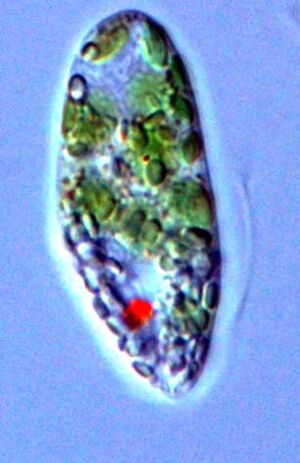Euglena (nonfiction)
Euglena is a genus of single cell flagellate eukaryotics.
It is the best known and most widely studied member of the class Euglenoidea, a diverse group containing some 54 genera and at least 800 species.
Species of Euglena are found in freshwater and salt water.
They are often abundant in quiet inland waters where they may bloom in numbers sufficient to color the surface of ponds and ditches green (E. viridis) or red (E. sanguinea).
The species Euglena gracilis has been used extensively in the laboratory as a model organism.
Most species of Euglena have photosynthesizing chloroplasts within the body of the cell, which enable them to feed by autotrophy, like plants. However, they can also take nourishment heterotrophically, like animals.
Since Euglena have features of both animals and plants, early taxonomists, working within the Linnaean three-kingdom system of biological classification, found them difficult to classify. It was the question of where to put such "unclassifiable" creatures that prompted Ernst Haeckel to add a third living kingdom (a fourth kingdom in toto) to the Animale, Vegetabile (and Lapideum, "mineral") of Linnaeus: the Kingdom Protista.
In the News
1974: Euglena Junction wins the Prime Time Emmy for Best New Show. Broadcasting live from the Pantages Theater via NBC, host Johnny Carson calls it "an extraordinary study of the genus Euglena, and a brilliant parody of Petticoat Junction."
Fiction cross-reference
Nonfiction cross-reference
Euglena data:
- Length ranges are 34-78 and width 5-24 micrometers
- Predators include: baby fish, water fleas, mussels, frogs, salamanders, and creek chub.
- Prey include: green algae, amoeba, paramecium, and rotifer.
External links:
- Euglena @ Wikipedia
- Petticoat Junction @ Wikipedia.com
- Euglena @ Wikimedia Commons
Attribution:

